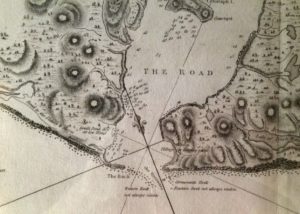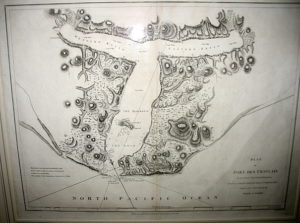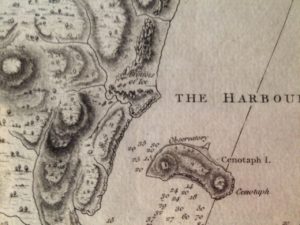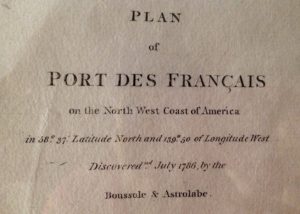
Here’s a fair question: How does a middle-aged American woman with no experience at sea come to write a novel about 18th-century French mariners?
Well, a mapseller in San Francisco is entirely to blame. Whether he was incompetent or unscrupulous, I’ll never know, but if not for him, I would never have written Landfalls.
He sold the map (pictured below) to my husband, telling him it was an 18th-century map of San Francisco Bay.

The map was a birthday present for me. I’ve always loved antique maps but didn’t actually own any. They’re rather expensive, as you probably know. At the time, however—it was the early 2000s—we were both gainfully employed in San Francisco at the sorts of jobs where one makes decent money and experiences a lot of stress for no particularly ennobling reason. The map is one of the nicer things I took away from that time. Much nicer, for instance, than the job-related repetitive stress injury that, more than a decade later, has never really gotten better.

We hung the map in our San Francisco hallway, and I used to stop and look at it, curious about the misshapen rendering of the familiar bay, so oddly suggestive of the female reproductive system, and the puzzling inclusion of geographically unlikely elements like “Grottoes of Ice” and “Eastern Glacier.” But if you looked at it sideways, you could imagine that here was the Golden Gate and this was the peninsula that would become San Francisco and this the future enclave of Marin and this the island we know as Alcatraz.
The cartouche on the map read—well, let me show you (click to enlarge):
 After a few months of pondering these mysteries, I woke up. Port des Français? Huh? The French hadn’t “discovered” San Francisco Bay, which is obviously named after Saint Francis, not Frenchmen. And wasn’t that latitude too far north for San Francisco? And the date—1786—surely Europeans had long since imposed themselves on the Bay Area by then. What was up with this map?
After a few months of pondering these mysteries, I woke up. Port des Français? Huh? The French hadn’t “discovered” San Francisco Bay, which is obviously named after Saint Francis, not Frenchmen. And wasn’t that latitude too far north for San Francisco? And the date—1786—surely Europeans had long since imposed themselves on the Bay Area by then. What was up with this map?
Today I would have Googled all of this much earlier. Today, my husband would probably have consulted Google even before leaving the mapseller’s shop. And I would have no story to tell. But in the early aughts it wasn’t yet second nature to run to the Internet every time one had a question. Sometimes one held a mystery in one’s head for months at a time.
But even then, it took all of five minutes to determine that the map was of a bay in Alaska, not California. That the place labeled “Port des Français” is now called Lituya Bay. That it’s still a remote, forbidding area that attracts few residents or visitors. That in 1958 a megatsunami, created by an earthquake-triggered landslide in the interior of the bay, had driven a wall of water out toward the sea, scouring the promontories clean and killing two people in a fishing boat. That the first Europeans to see the place had, indeed, arrived in 1786 on two ships called La Boussole and L’Astrolabe. That they had comprised the Lapérouse expedition, an expedition that—my God, what an amazing, heartbreaking story! I kept clicking and scrolling and reading and clicking and scrolling and clicking some more, mesmerized.
Wow, I thought, looking at my birthday present. Wouldn’t it be cool to write a bunch of stories about this expedition, each one taking place at a different point along its route and focusing on or told by a different person, all of it bringing to fictional life the remarkable events of the voyage?
It was almost that fast. I learned about the expedition and then I had the idea for the book.
I tingled all over. It was a good idea. It was a great idea.
But it was crazy. I didn’t know anything—not about ships or the history of exploration or the Age of Sail. Not about the so-called Age of Enlightenment or life at the end of the Ancien Régime. As a kid, I’d been on a sailboat with my family a few times, but I’d never actually sailed. I’d never spent a night on the ocean. I liked doing research, but the kind of research this project would require—I had no academic affiliation, no university library access. I didn’t even read French. My college degree was in Japanese. And while I’d dabbled in fiction for years, I’d never published anything.
So yeah, it was a good idea. Maybe even a great idea. But I obviously didn’t have what it took to pull it off.
Yet I couldn’t shake it. That tingly excitement shaded into tingly paranoia. If I didn’t write the book, I thought, someone else would. I would lie awake at night wondering if it was already too late—if someone somewhere had already started writing it. In hindsight, this seems like the kind of utterly unfounded fear that only the colossal narcissism of an artist could devise, but there you are.
Meanwhile I was raising two rambunctious children and burning myself out through a succession of publishing jobs and working on a children’s fantasy novel about people who could alter reality by messing about with maps (yes, there’s a recurring “maps” thing here). Eventually I ended up on disability, my right arm damaged by altogether too much keyboarding. We couldn’t afford life in San Francisco on my husband’s income alone, so we moved to the Central Valley town of Davis—not an inexpensive place, but a lot cheaper than the City.
For months I tried to stay the course with the fantasy novel. It was basically a Harry Potter knockoff accessorized with arcane cartographic details. I wrote hundreds of pages. Some of them were actually pretty good.

But I was still obsessed with the Lapérouse expedition. And now that I lived a fifteen-minute bike ride from UC Davis and its world-class research library, the compulsion was easier to indulge. When I found John Dunmore’s translation of Lapérouse’s journals, published in two volumes by the Hakluyt Society in 1994, I devoured it. (I eventually splurged on my own set, which became my boon companions through the entire project.) One compelling story idea after another tumbled out of its pages, especially from the small print of the footnotes and appendices.
That tingly feeling returned. Only this time I wasn’t so sure the project was impossible.
I’ve already described in one blog post the writing of the very first piece for the book, in 2004. That fall I applied—and was admitted—to the Masters in Creative Writing program at UC Davis. I wanted to get some professional feedback on my writing. But I also wanted—badly—to have full access to that library. The summer before I enrolled, I took intensive French so I could expand my research, and during my two years there, I made ample use of the library and that most glorious of library amenities, inter-library loan.
When I graduated in the spring of 2007, I turned in The King’s Voyage and Other Stories, eight linked short stories about the Lapérouse expedition, the skeleton of what would eventually become Landfalls, a novel with prologue, epilogue, and fourteen chapters in between.
And that’s how I came to write Landfalls. It doesn’t really explain why I was so drawn to the topic, of course. I have some theories about this, which I may try to address in a separate blog post at some point.
Meanwhile, the book is coming out in North America on Tuesday, August 4! There’s information on international release dates and pre-ordering here and book appearances here. I hope to see some of you in the next year as I travel about peddling my unlikely book!
Finally, if you’d like to keep up with what I’m up to—readings and other events, new blog posts, other publications, etc.—please sign up for Dispatches, my never-more-often-than-monthly e-mail newsletter. There’s a link to sign up at the top right of every page.
Dear Naomi,
just wanted to tell you how much I love reading your blog posts. During the translation process (I’m the german translator of your novel – remember?) I often asked myself how on earth a female American writer came to write such a novel. Your answer is fantastic! It is also interesting to gain some insight into the life and work of an author, about the family background, how stressful it is to earn a living in an expensive city (Munich is expensive as well, and although I enjoy living here my husband and me sometimes think about moving to a less expensive place …).
I keep my fingers crossed, that your novel will get the success it deserves, and wish you all the best for your further literary endeavors.
Best Regards from Munich, Monika
Hi, Monika, and of course I remember who you are! 🙂 I’m glad my piece answered some questions for you. I could write a whole new post just about my sorrow over leaving San Francisco & the various ways I’ve grown accustomed to/made peace with/started to actually appreciate life in a less exciting place. My fantasy is to become a wealthy bestselling author (haha!) & buy a nice pied-à-terre in the city, but … well, a girl can dream, as they say. Thank you so much for reading & for your comments!
This is a great post. Strange, isn’t it, how an idea can take hold and force you to do research you never expected to do. I’m impressed that a summer of French intensive enabled you to research French texts. I’ll be at your Avid Reader signing, August 9th.
Does the mapseller know? 😉
Oops- just saw the above. A little too quick on the scrolling arrow.
No worries — thanks for reading! 🙂
This tale is just terrific, and I’m really happy to be reminded that it all began with an error. Have you considered contacting the mapseller (if they’re still in business) to inquire about whether it might be possible to read there?
Thanks, Rae. You know, I’ve never considered contacting the mapseller. Not sure how much they’d appreciate being called either “incompetent or unscrupulous”! But this is an intriguing suggestion, and I could at least think about reaching out to *other* mapsellers around the country…